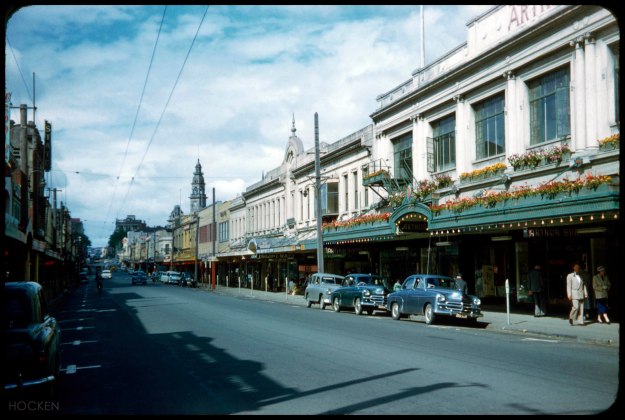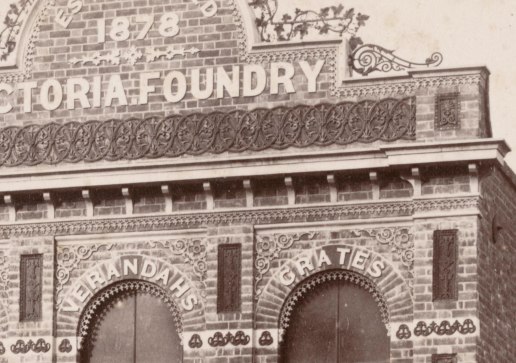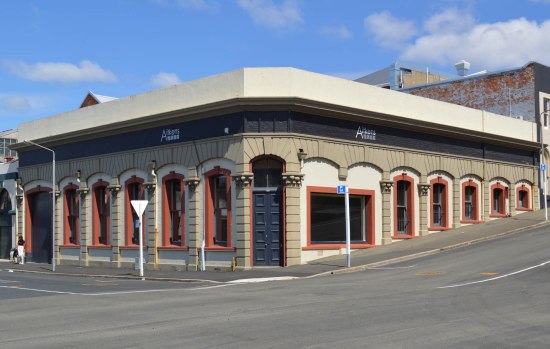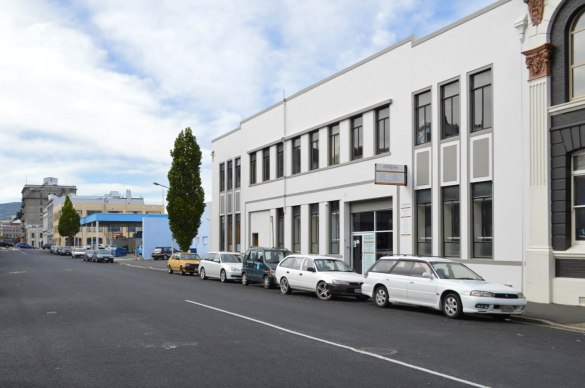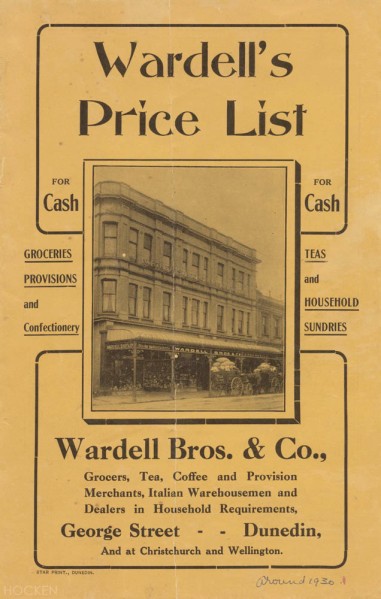Built: 1930-1931
Address: 242 Stuart Street
Architects: Mandeno & Fraser (Roy Fraser)
Builders: W.H. Naylor Ltd
![]()
This elegant Arts-and-Crafts-style house was designed by Roy Fraser of Mandeno & Fraser, and begun just months after the completion of that architectural partnership’s best-known project: the nearby Dunedin Town Hall. The house draws from English domestic architecture, with imaginative combinations of forms, and many charming touches such as contrasting gable ends, an oriel window, copper work, and patterned brickwork. This last element can be seen in other Mandeno & Fraser designs, such as the Central Fire Station, Speight’s Brewery, and a more modest house at 27 London Street. The frontage comes right to the street line, giving the house a strong urban quality, emphasised by its close relationship with the flats next door, which were designed by Coombs & White in 1926.
The building was originally the Perry family home, and included the professional rooms of Dr Arnold Perry (1899-1977). Perry (known to friends and family as Fred) was born in Wellington and trained at the Otago Medical School and in London, where he married Lygia Duthie in 1926. After returning to Dunedin the following year, he worked at Dunedin Hospital, taught at the Otago Medical School, and established a private practice. Stuart Street was an ideal central location for a new family home.
![]()
Fred and Lygia Perry, Dunedin Town Hall, 1947
![]()
Watercolour by Thomas Lusk (Mandeno & Fraser)
The builders W.H. Naylor Ltd submitted a tender on 21 November 1930 and their final account, dated 4 November 1931, was for £3,226. The architects’ fees were not settled until 1933, and workmen who did not have other jobs to go to were kept on with extras at a difficult time in the Great Depression.
The family’s living areas were at the rear of the house, where extensive glazing exploited the sun and garden views. The surgery and waiting room had a separate entrance (now blocked) facing Stuart Street, while a private entrance was on the west side of the house. An addition to the surgery built in 1939 extended over the path between the house and the neighbouring flats.
The interior draws from both the Arts and Crafts and Art Deco styles. Leadlights incorporate geometric patterns, and a feature window depicts a medieval soldier above the motto Fide et Fiducia (Strength and Loyalty), in a design more fanciful than truly heraldic. The bathroom was modern for its time, with yellow-coloured tiles, terrazzo flooring, and a streamlined bathtub.
![]()
Stained glass windows above the stair landing
![]()
The original private entrance
![]()
First floor plan, drawn in October 1930
![]()
Ground floor plan, drawn in October 1930
Aileen Fenton remembers a very happy childhood as the middle of the three Perry children, and after I contacted her to ask about the house (she now lives in Lower Hutt) she kindly wrote the following reminiscences. They bring a warmth and personal feeling to the story that a simple historical narrative could never achieve, because this was her home.
242 Stuart Street, or no.55 before the street realignment, was a marvellous family home. The house was planned to have the living family quarters at the back of the house, with large windows facing north, onto the private garden, and a separate entrance to Dr Perry’s surgery and waiting room on the south aspect. Under the surgery, the deep garage had a cupboard built into one wall, with a heavy iron door. This was called the anaesthetic cupboard, where Dr Perry stored gas cylinders and special medicines for his practice.
Dr and Mrs Perry had three children, John, Aileen and James (Jim), and I was the middle one and only girl. My childhood was a very happy one, and it was so convenient being close to the city centre. With the cable car travelling up and down Stuart Street, the drivers would often ring the car bell outside our house to encourage us to hurry up. We would clamber on with our bikes put in front nets, on the way to Highgate and to school. What fun it was hanging by a strap on the outside of the car, swinging out and touching the trees and bushes by the side of the track in Upper Stuart Street.
![]()
Dr and Mrs Perry with their children, James (Jim), Aileen, and John, c.1938
It was tremendous fun in winter with snow about, when we would take our simple wooden sledges – stored at the back of the garage – and slide down the Cathedral steps, finishing up by the Robert Burns statue. The verger would come out waving a fist at us!
My father had a very busy general practice which he combined with obstetrics and gynaecology, and hospital work. His nurse was part of the family, and my mother often looked after babies and small children, while parents had an appointment. Patient consultations were usually late morning, and evening from 6.20pm. We always had to have an evening meal sharp at 6pm, to enable my father to see his patients. For much of his time, Dr Perry visited patients in their own homes, and even in deep snow storms on would go the chains on his car tyres, so he could visit the hill suburbs.
Many times I remember family outings would be cancelled because a patient had come into labour, so a picnic would be unpacked and celebrated on our back lawn instead. During the severe polio epidemic of 1938-39 my father was extremely busy, but because of possible infection, the rest of our family went to stay in our bach at Taieri Mouth, and didn’t see our father for two months. All schools were closed at that time.
There was only one telephone in the house – sited on the wall between the kitchen and cloakroom, with an extension to the surgery, and main bedroom. Woe betide anyone who stayed chatting on the phone longer than a couple of minutes – it was a very busy line.
For many years we had a live-in maid, who had her own bedroom situated above the surgery, facing the street. A great asset in such a busy household. In the kitchen there was a series of ‘star bells’ (a-la-Downton Abbey!) on the wall beside the inside door, for the maid to answer the dining room, sitting room etc.
![]()
The kitchen
The kitchen was rather dark with windows onto the next door house. My father was able to get permission from the neighbours to paint the brick wall white, and so lighten the room. A mottled green cast iron gas stove mounted on legs stood sentinel in an alcove in the kitchen, and I still remember the excitement when a new fridge was installed.
Off the kitchen, past the coal cupboard was the washroom or laundry, leading to the back garden rotary clothes line. The laundry originally had two huge concrete tubs and a large copper. Washing day was a big event with starch used on shirts, aprons et. As with the fridge, washing machine and wringer were exciting new additions.
Beside the front door, under the gracious stairs, was a capacious coat and storage cupboard. A great repository for preserves such as vaselined eggs, bags of Central Otago walnuts, large tins of honey, and preserved fruit. It was also a great hiding place!
Our piano was sited in a corner of the sitting room, which was facing north, to the left of the front door. Formal parties and bridge evenings were often held here, and an efficient cosy fireplace was a focal point. An alcove had been fashioned in one wall to take a beautiful Chiparus figure, and showcase this.
![]()
The former sitting room
![]()
Door handle detail
The dining room was the ‘hub’ of the house, with the table alcove, book shelves, bay widow, bevelled mirror over a fireplace and hearth. The efficient fire was kept stoked all day long in winter and was so cosy. Always warm and sunny, with windows onto the garden, the room opened into the ‘playroom’ or sun porch which had access to the garden. Here there was a great cupboard which housed toys, sewing and ironing equipment. This room had a good low windowsill, which was great to sit on with one’s back to the sun.
As a former All Black, Arnold Perry was also the rugby doctor and keen follower of the game. After Carisbrook matches our house was often full of rugby players and followers on Saturday evenings. Family friends often found our home a handy place to visit after, or before shopping in town. Also a great gathering home for many young teens before going off down to the town hall for ‘Joe Brown’s’ 2/6d. Saturday evening dances.
![]()
Bathroom. The original terrazzo flooring is likely beneath the cork tiles.
Upstairs, the family bedrooms faced north, and onto the garden, and were roomy and comfortable with built-in wardrobes. The bathroom was modern for its time, with the use of tiles and special terrazzo flooring. The third top step of the stairs creaked, so one had to be careful coming home late, to try to avoid disturbing parents!
Our sunny back garden was an oasis, and both Dr and Mrs Perry were keen gardeners. My father was particularly fond of his rose garden in the north-east corner. In the centre of the lawn was a particularly lovely weeping elm tree where family enjoyed picnicking and playing. For many years the back of the house was covered in Virginia creeper, which looked quite magnificent in autumn. Concern about it invading brickwork and guttering caused its sad demise.
![]()
The weeping elm in 1950
![]()
The rear, north-facing elevation of the house
Spring cleaning was a major event each year. The whole family became involved and had to help. Out came each book to be dusted and then put back onto the cleaned shelves, all furniture and woodwork had to be polished, hinges on doors and windows cleaned and oiled. All nooks and crannies scoured, and curtains were taken down and washed (winter ones were replaced by summer curtains), mats taken out and beaten, all silver polished as well. Even the stair rails were taken off and cleaned behind. Particular care was taken with the surgery, where the smell of disinfectant pervaded for some time. Included in the clean-up was the patient’s examination couch and dressing area which was situated in the extension built on in 1939. Occasionally now, my husband will say to me, ‘We need to do a Mother Perry spring clean!’
As a fun project, we collected old Christmas and birthday cards, cut out the attractive pieces and pasted them into large scrapbooks, for the waiting room. These proved to be so popular with young children.
The war years were difficult. As a keen naval man, my father joined H.M.S. Achilles as ship’s surgeon, and was on board for the first three years of the war. We were all particularly worried at the time of the Coral Sea battle off the East coast of Australia, but later learned that the Achilles and Leander ships were kept South in defence.
![]()
Ship’s complement, HMS Achilles, c.1941
For the last three years of the war, Dr. Perry was stationed at Devonport Naval Base, as Director of Naval Medical Services. In 1946 with the rank of Surgeon Commander, he was awarded the O.B.E. He had been awarded the V.R.D. in 1944.
After the war he continued to serve in the Naval Reserve, when was promoted to the rank of Surgeon Captain. He was Honorary Surgeon to the Governor General in 1952-53, and retired from the Navy in 1956 after 28 years of unbroken service.
In 1946 Dr Perry was appointed to the staff of Dunedin Hospital and the Medical School. As obstetrics became his main interest he also became Medical Superintendent of the Salvation Army’s Maternity Hospital of Redroofs. He always showed a particular empathy, kindness and care towards the unmarried others. When he retired from Redroofs in 1971, he was awarded the Distinguished Service Order for rendering outstanding service.
As the O.R.F.U. medical officer he took a deep interest in the activities of the St John’s Ambulance men who patiently manned the sidelines of rugby fields. He assisted with their first aid training, and on going to sea in H.M.S. Achilles he used St John’s methods and systems in teaching first aid to officers and men in the Navy. He was made an Officer of the Order of St John of Jerusalem in 1947.
![]()
The Perry family outside the sitting room, c.1950
Our mother, Lygia, was a foundation pupil of Columba College, and had the honour of cutting the cake on stage at the town hall, at the age of 90, to commemorate the 75th Anniversary of the school. She also cut the ribbon to open a new school building. Mrs Perry was president of the Columba Old Girls’ Society for a few years, and at the debutante balls held in the Town Hall, the College girls and their partners were presented to my mother and father. I used to enjoy watching my mother dressing for formal occasions. Her wardrobe contained many elegant long dresses, and with long white gloves, jewellery, and fur stole. I used to think she was so glamorous.
Both our parents, as the last of seven children in their respective families, had unhappy difficult childhoods, so it was amazing that they became such wonderful caring parents, and were so devoted to each other.
A great family home, well planned and built, 242 Stuart Street was a perfect venue to prepare and eave from, for my wedding at First Church in January 1953.
![]()
![]()
![]()
References:
Job records, Oakley Gray Architects
Wright, J.L., ‘Perry, Arnold (1899-1977)’ in Southern People: A Dictionary of Otago and Southland Biography (Dunedin: Longacre, 1998), pp.386-387.
Stone’s Otago and Southland Directory
Wise’s New Zealand Post Office Directory
Telephone directories
Dunedin City Council permit records and deposited plans
Thank you to Hamish Wixon and McCoy & Wixon for letting me look around the building and take photographs, to Norman Oakley for information from the Oakley Gray records, to Steve Perry for scanning the watercolour, and to Aileen Fenton for sharing personal memories and photographs of her childhood home.
![]()
![PerryHouse_Garage]()
![]()
![]()
![]()
![]()












































